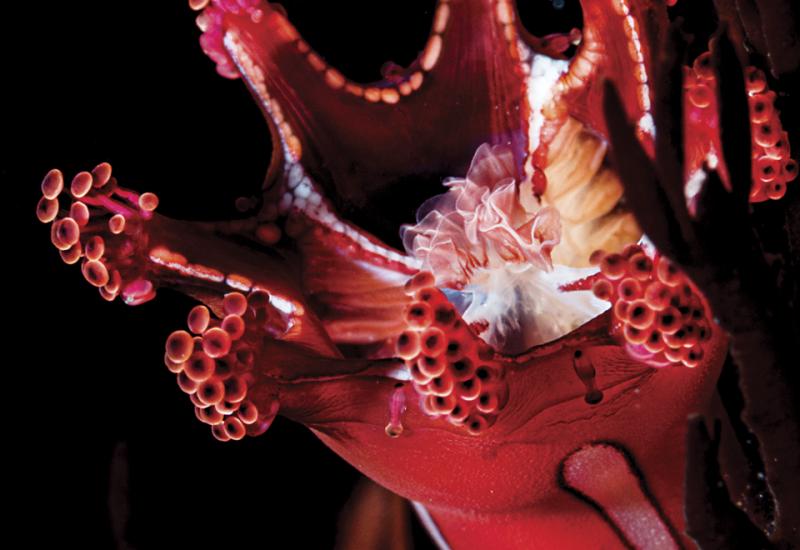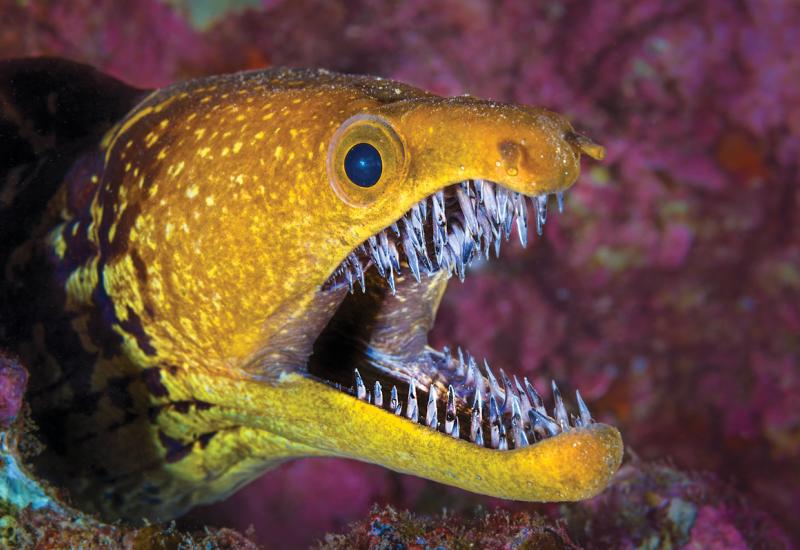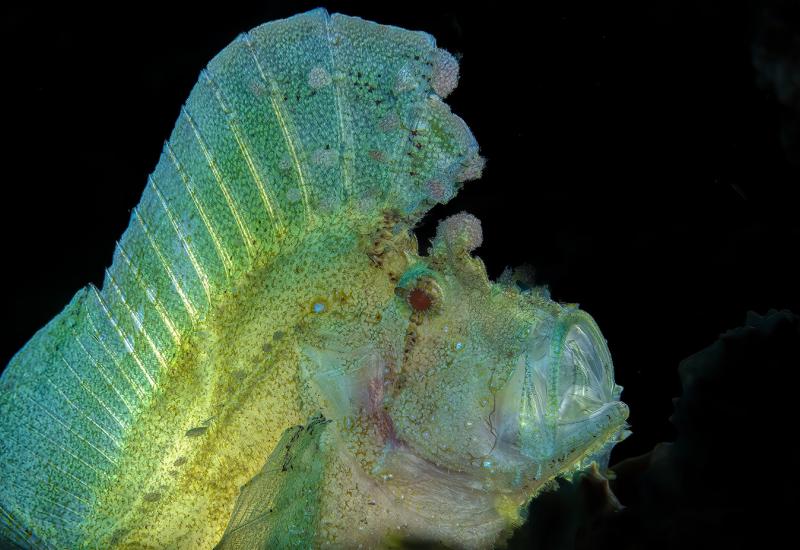BOO! Spooky Eels from Around the World
Eely Spooky Fish
With long, undulating bodies, most eels look a lot like snakes, but they are in fact fish. Eels can be very scary looking creatures as many varieties “gasp” constantly (which looks like a cross between biting and gulping behavior), and in doing so, bare their often-sharp fangs. But what they are really doing is forcing water over their gills to breathe. Eels also often have big bulbous eyes, and strange tubular nostrils, which add to the overall spooky effect.
But eels are generally quite safe for divers to approach, although keeping a respectful distance is a good idea, as it is thought that eels do not see very well, and could mistake your fingers or hands for their regular diet of fish and crustaceans. They tend to retreat from divers into their dens on the reef when approached, and most often are only seen out free swimming while they hunt at night.
There have been a few documented incidents of eels biting and injuring divers. From what I understand, this was because the divers in question were attempting to hand feed eels, and the eels in turn bit the hand that was feeding them, most likely out of mistaken identity. People may also be bitten when gathering lobsters, as the lobster may be sharing real estate with an eel under a ledge or in hole on the reef, and eels do not like their lairs being disturbed or intruded upon. Eel bites can be very nasty injuries, as these animals can have razor sharp teeth and several species actually have a second jaw and set of teeth further down their throat, which act as barbs and can make it hard to get your hand back.
I have rarely seen eels behave aggressively towards each other, although I once witnessed a wild eel rodeo in the Galapagos (which is a very eely destination — the things fairly litter some of the sites). I am not sure what the trigger was, but there were a half dozen moray eels madly charging each other in some sort of excited melee. Yikes!
The only other good eel story I can share occurred when Mr. G and I were diving near Cabo San Lucas, when we were fairly new divers, which was many years ago now. We showed up at the harbor at the appointed hour and met our Mexican dive master. We watched, somewhat astonished, as he loaded his BC pockets with small dead bait fish. I remember turning to Mr. G and saying wryly, “no good can come of that.”
So off we went, dropping down on a dive not far from the beautiful arch. As we swam over a jumble of rocks, we saw one, then two, then several eels pop up out of their lairs, as if to say, “hm, I smell supper.” To compensate for their poor eyesight they apparently have a very keen sense of smell. One very large green eel then swam up out of the rocks and starting frisking the dive master. At first he was totally oblivious. We watched, from a safe distance, with both horror and humor, as the big eel wound himself around and through up between the diver’s legs to sniff at his BC pockets. Then, finally, the dive master looked down, realized what was happening, and freaked out! He pushed the eel away in a blaze of bubbles. Then he checked himself out all over to make sure the beast hadn’t bitten him, spinning wildly in the water as he did so, and then he opened his pockets and started flinging the fish bits away. His eyes were huge — borderline panic, and for the rest of the dive he kept checking his six, clearly worried that he was going to be the recipient of even more unwanted eel attention. I am betting that chumming the eels is no longer part of his dive guide routine ;^)
This gallery features 17 different types of eels of the many that I have photographed during my travels. The Caribbean is documented to have 7 different varieties of eels. The Tropical Pacific has over 70!
More Dive Adventures with Judy G
School Daze with Thousands of Fish | DANGER: Risky Reef Dwellers | Meeting Mr. Big
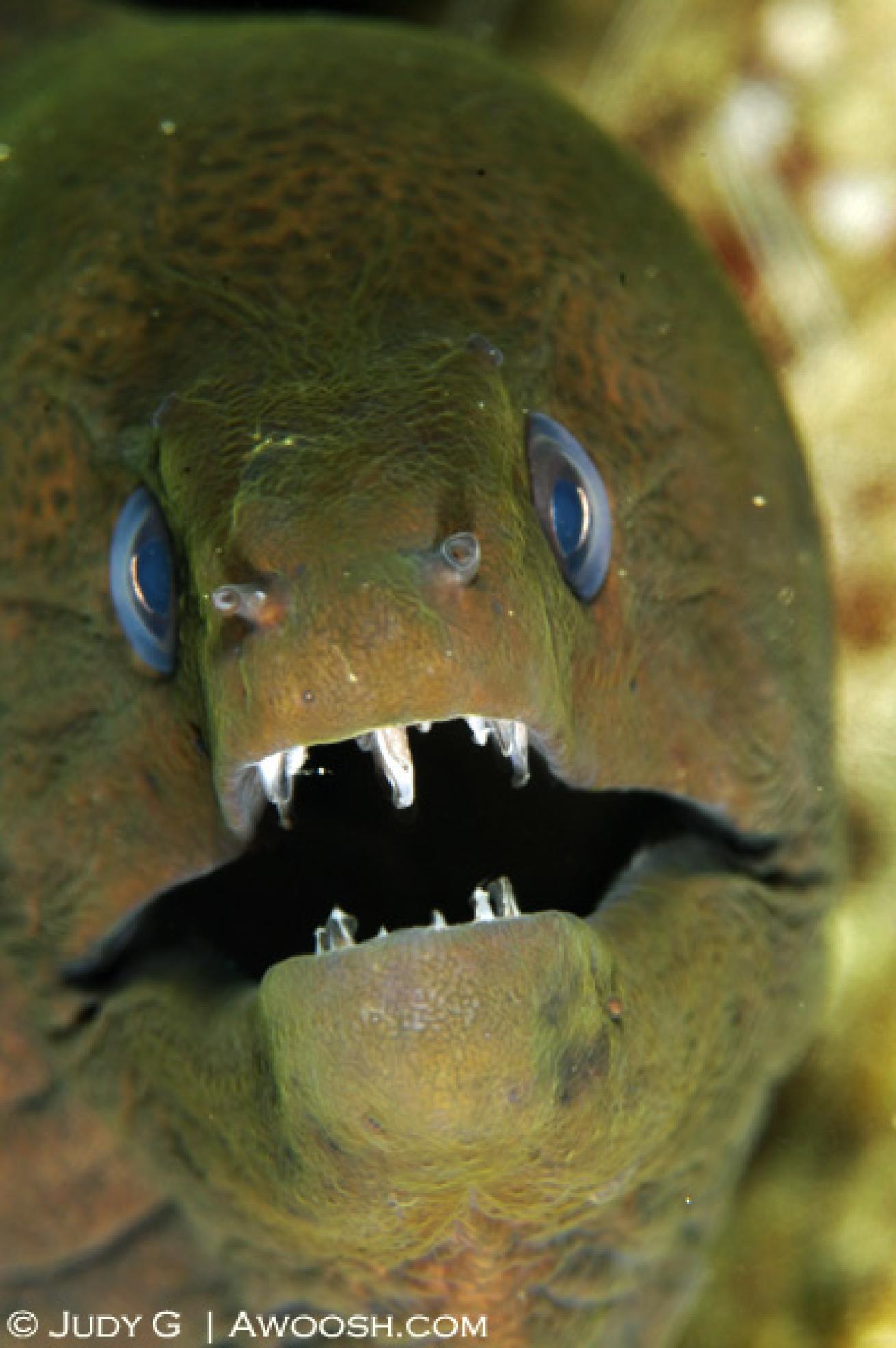
Judy G
(Cozumel)
These eels can grow to be quite huge. The largest I’ve seen was at least 5 feet long.
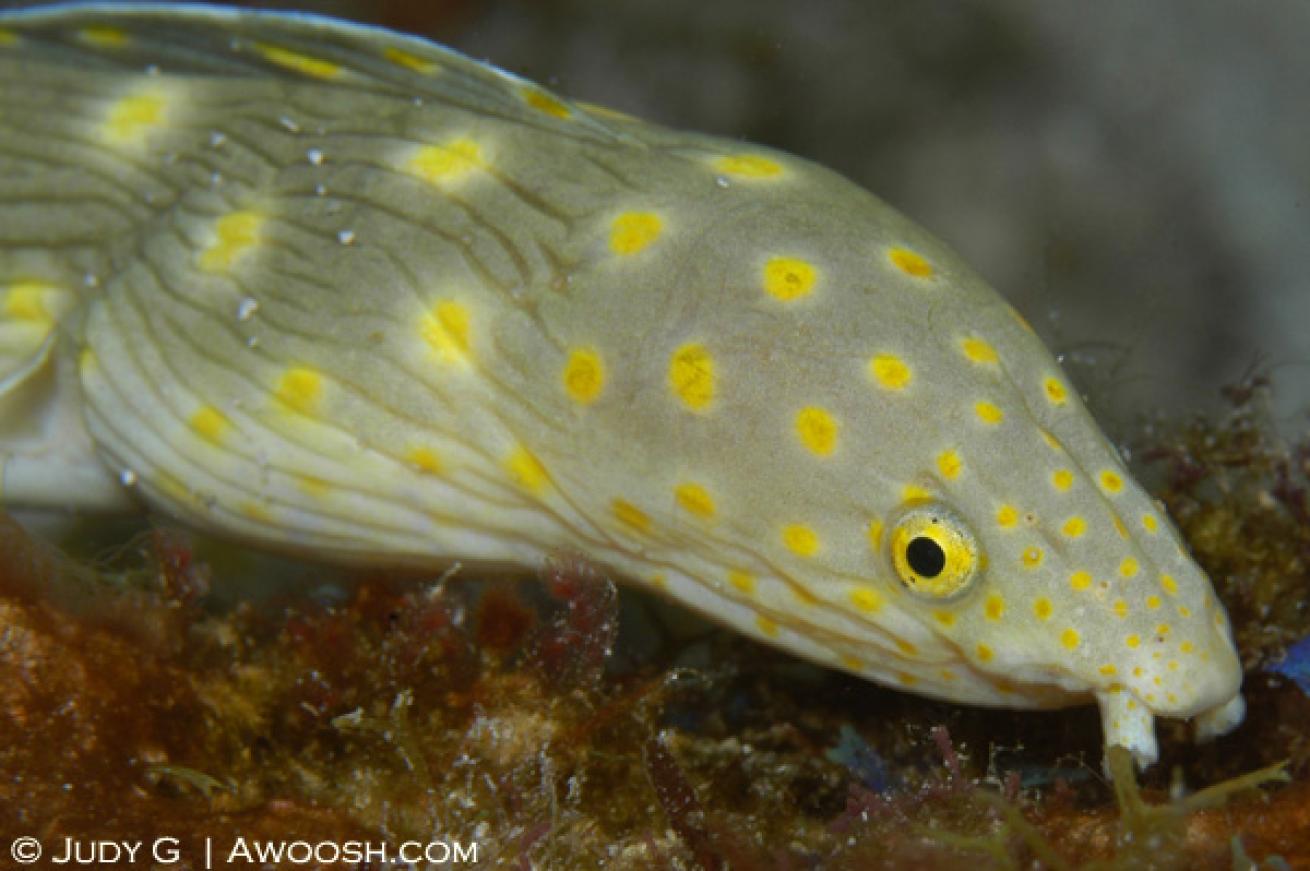
Judy G(Curacao)
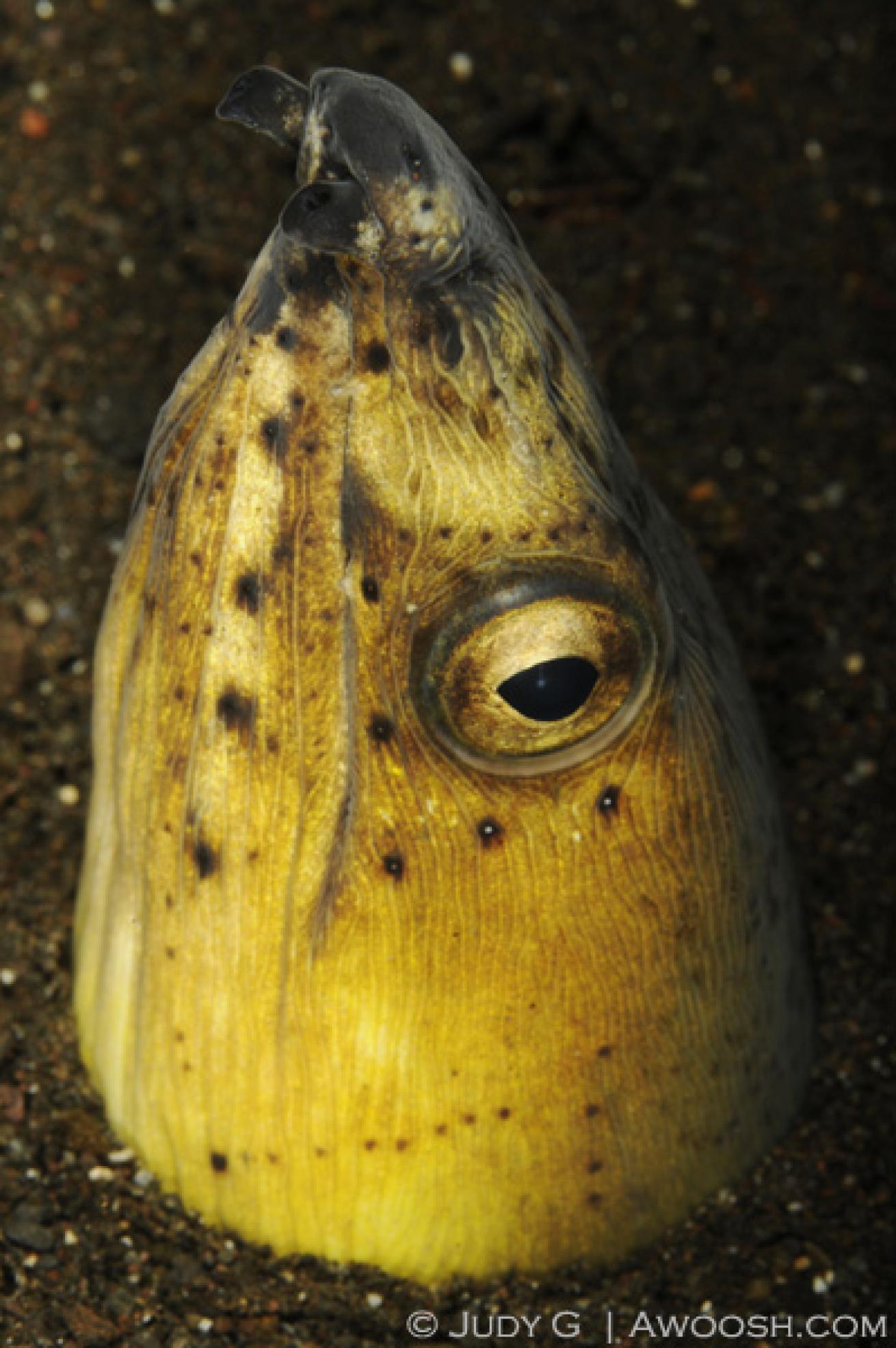
Judy G
(Komodo, Indonesia)
Snake Eels are really strange creatures. Rather than having a den in the rocks like many eels, they burrow down into sand or muck, so that just their head sticks up. From this clever lair they can strike lightening quick when a tasty tidbit swims overhead. I’ve seen one out on the reef at night hunting. It was incredible how quickly it could park itself back in the sand.
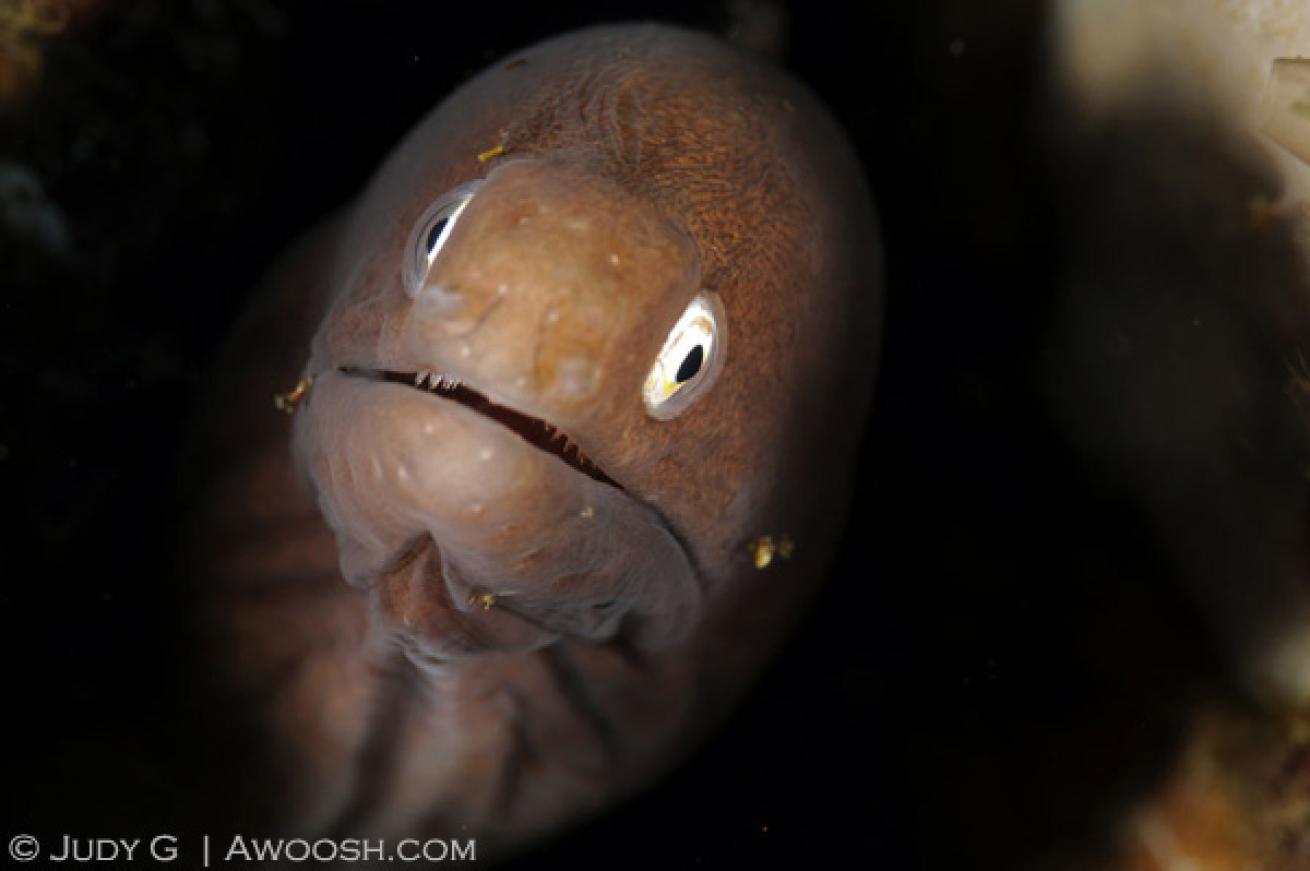
Judy G(Raja Ampat, Indonesia)
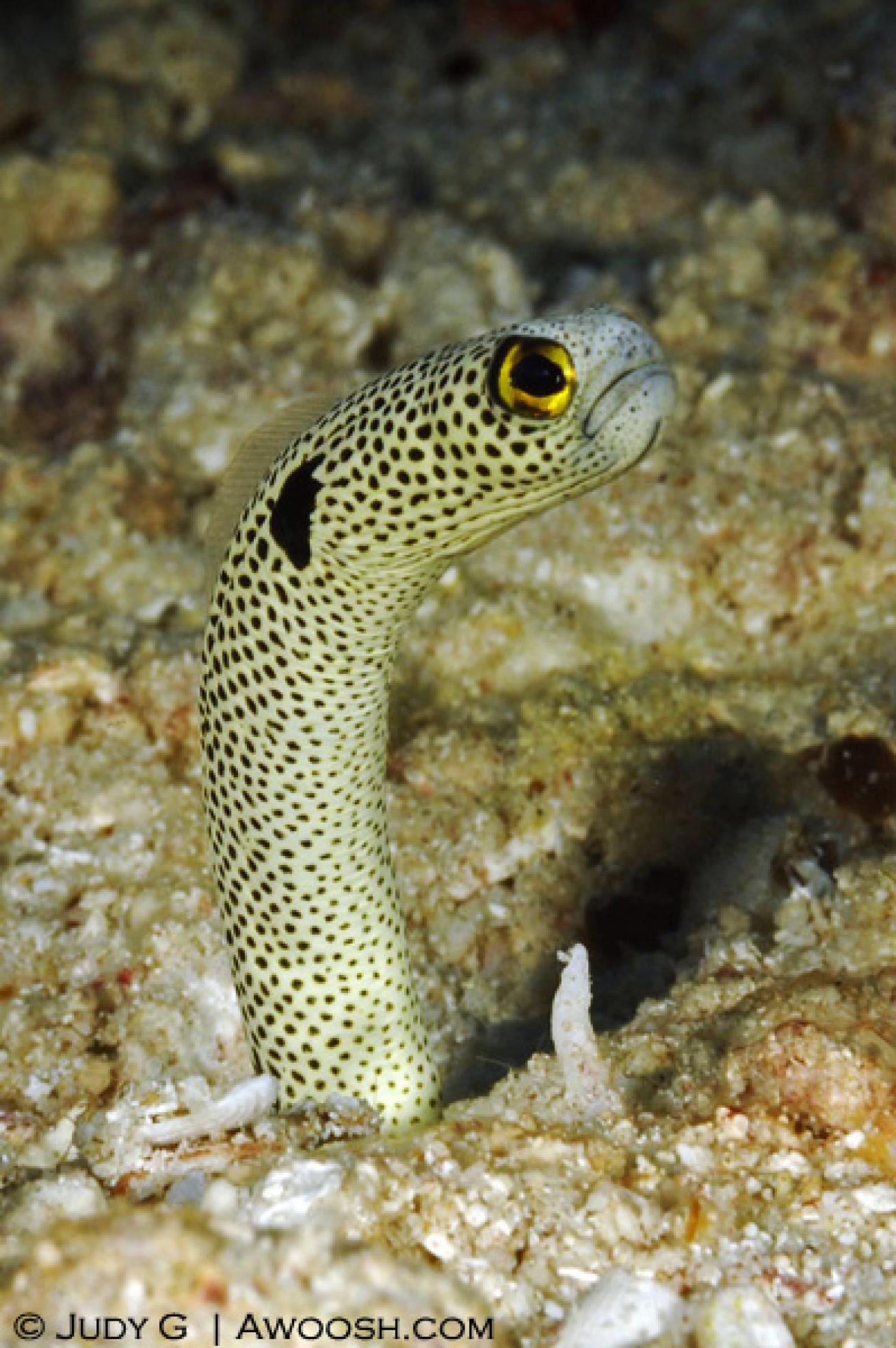
Judy G
(Banda Sea, Indonesia)
As its name suggests, garden eels tend to live in communities, and they are found in many locations. These are another bottom dwelling eel that lives in burrows. They wave in the current like sea grass as they snatch little flyby snacks. They will quickly recede back into their holes when divers or predators approach, and so they can be very difficult to photograph.
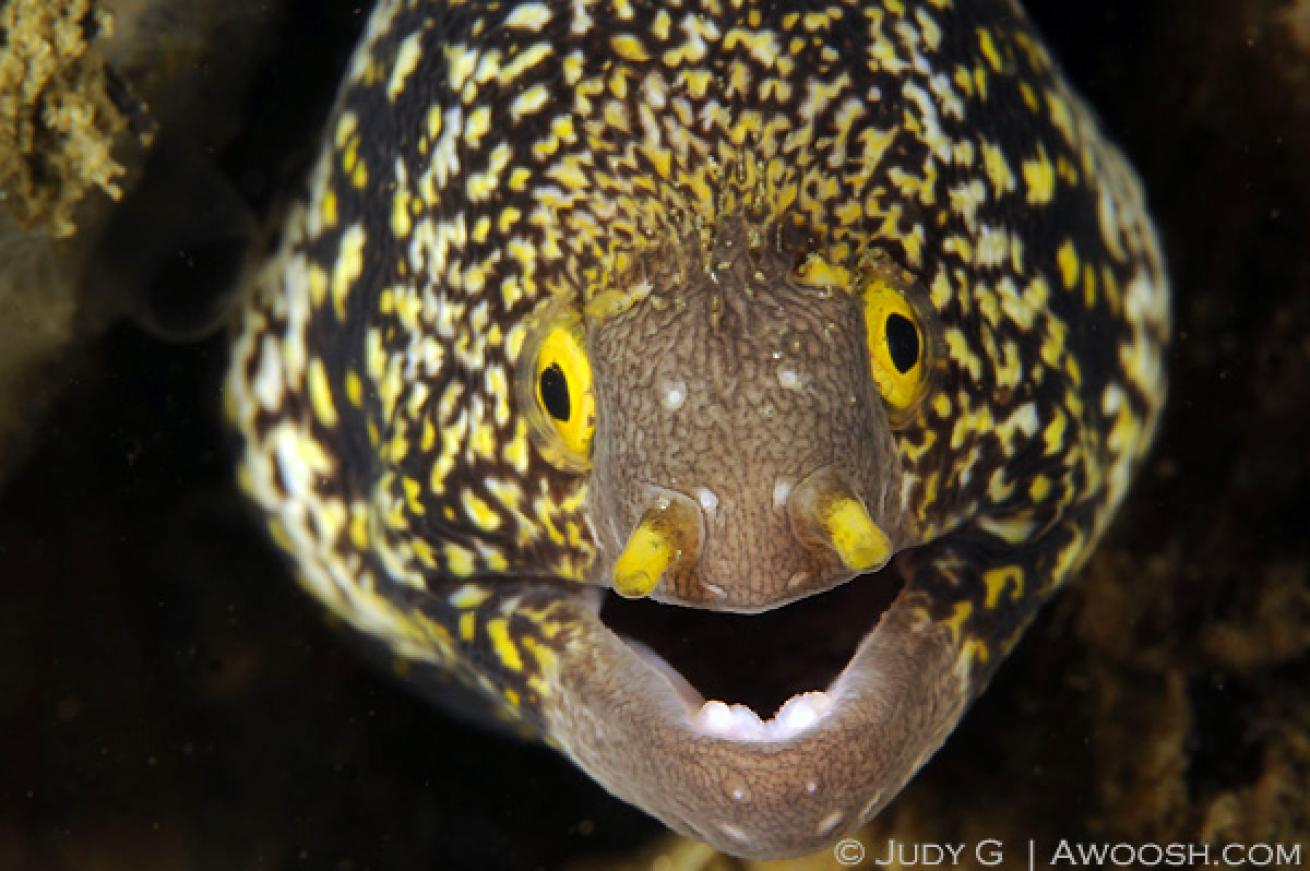
Judy G
(Ambon Island, Indonesia)
I love the coloration of this eel. These are quite common in Indonesia.
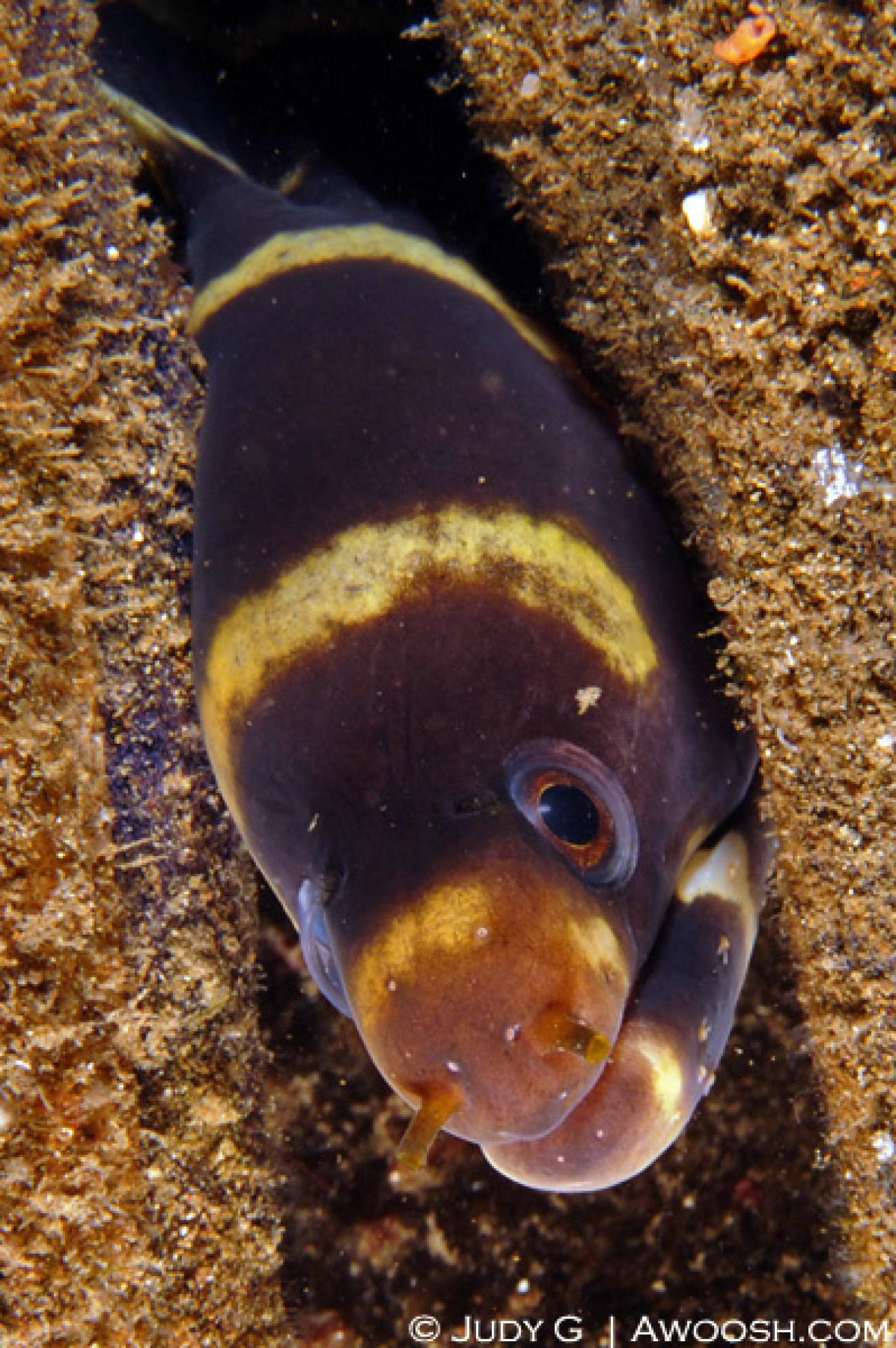
Judy G
(Ambon Island, Indonesia)
I’ve only seen one of this kind of eel. This image was captured at Laha dive site on Ambon Island – arguably the best muck site on the planet.
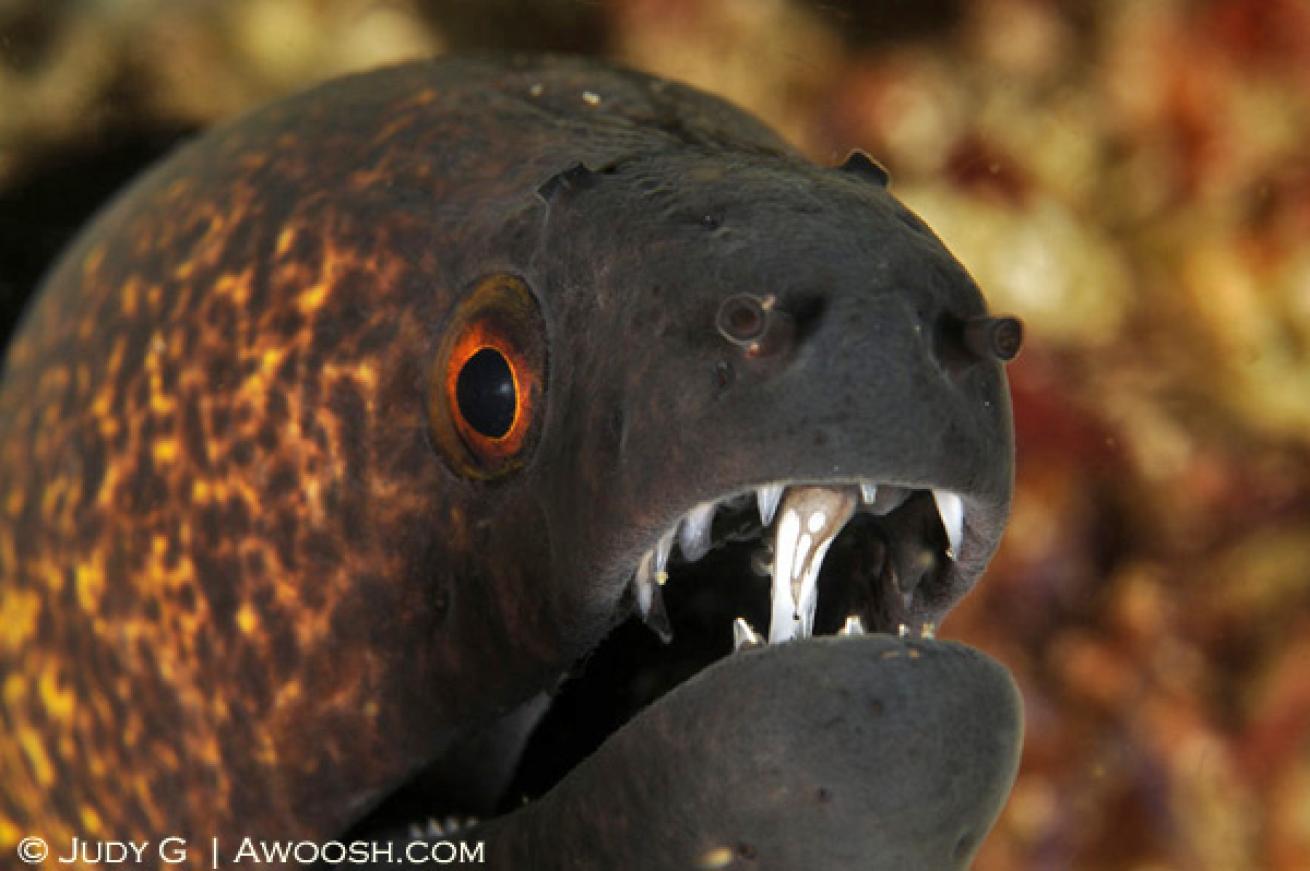
Judy G(Indonesia)
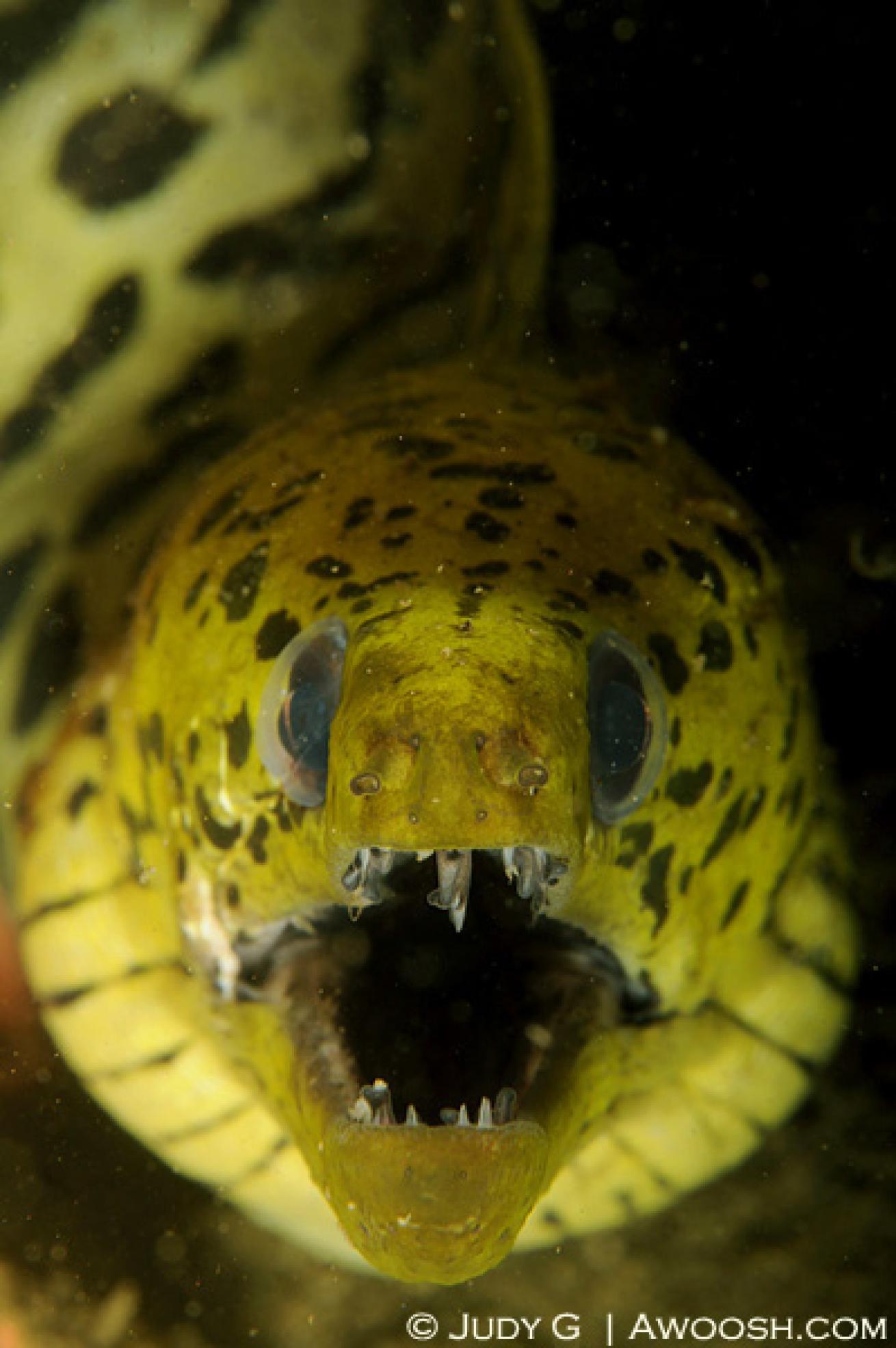
Judy G
(Banda Sea, Indonesia)
This is another eel that I have not seen a lot of. Its bright lime green coloration is quite beautiful.
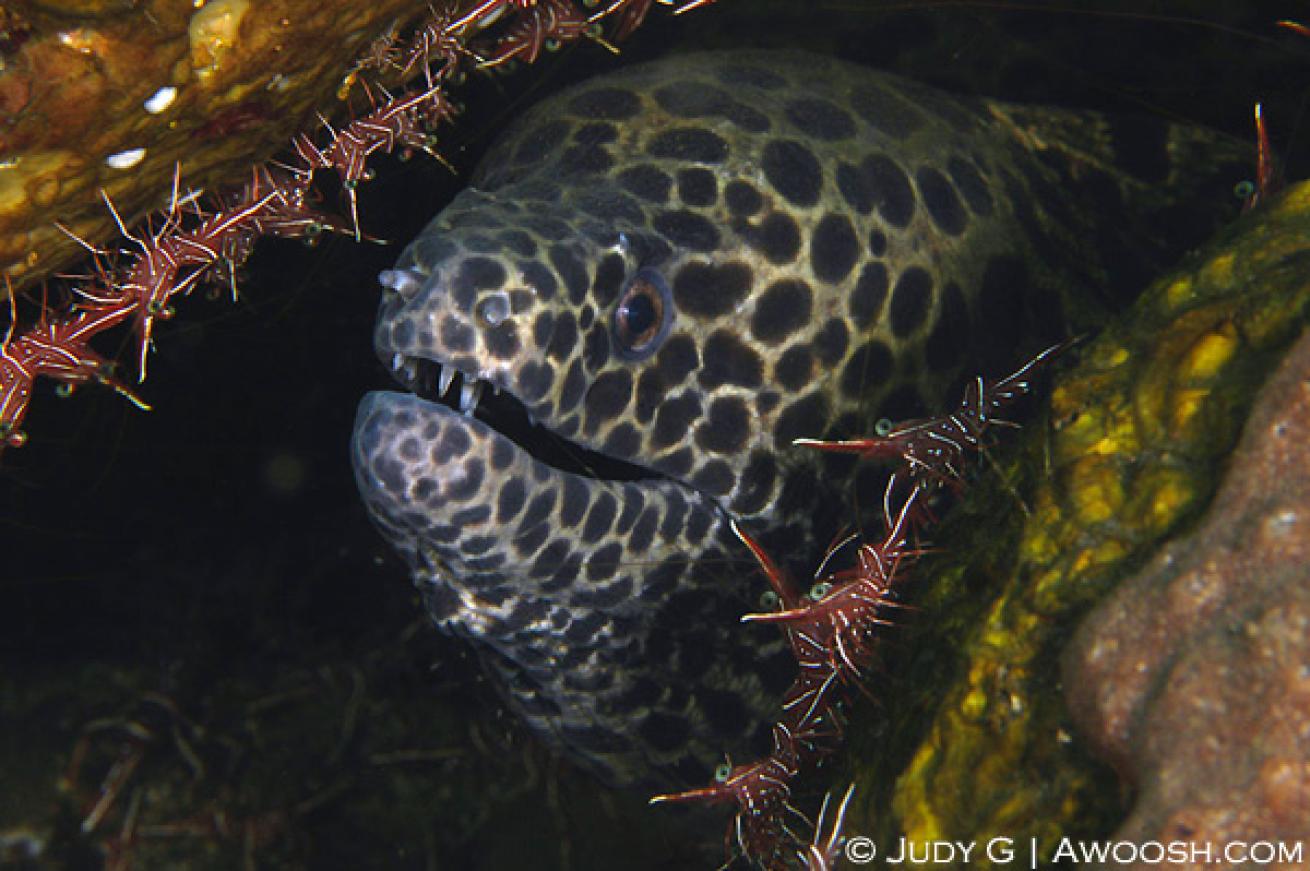
Judy G
(Ambon Island, Indonesia)
This was a huge eel, sharing its lair with an army of Hinge Beak shrimp
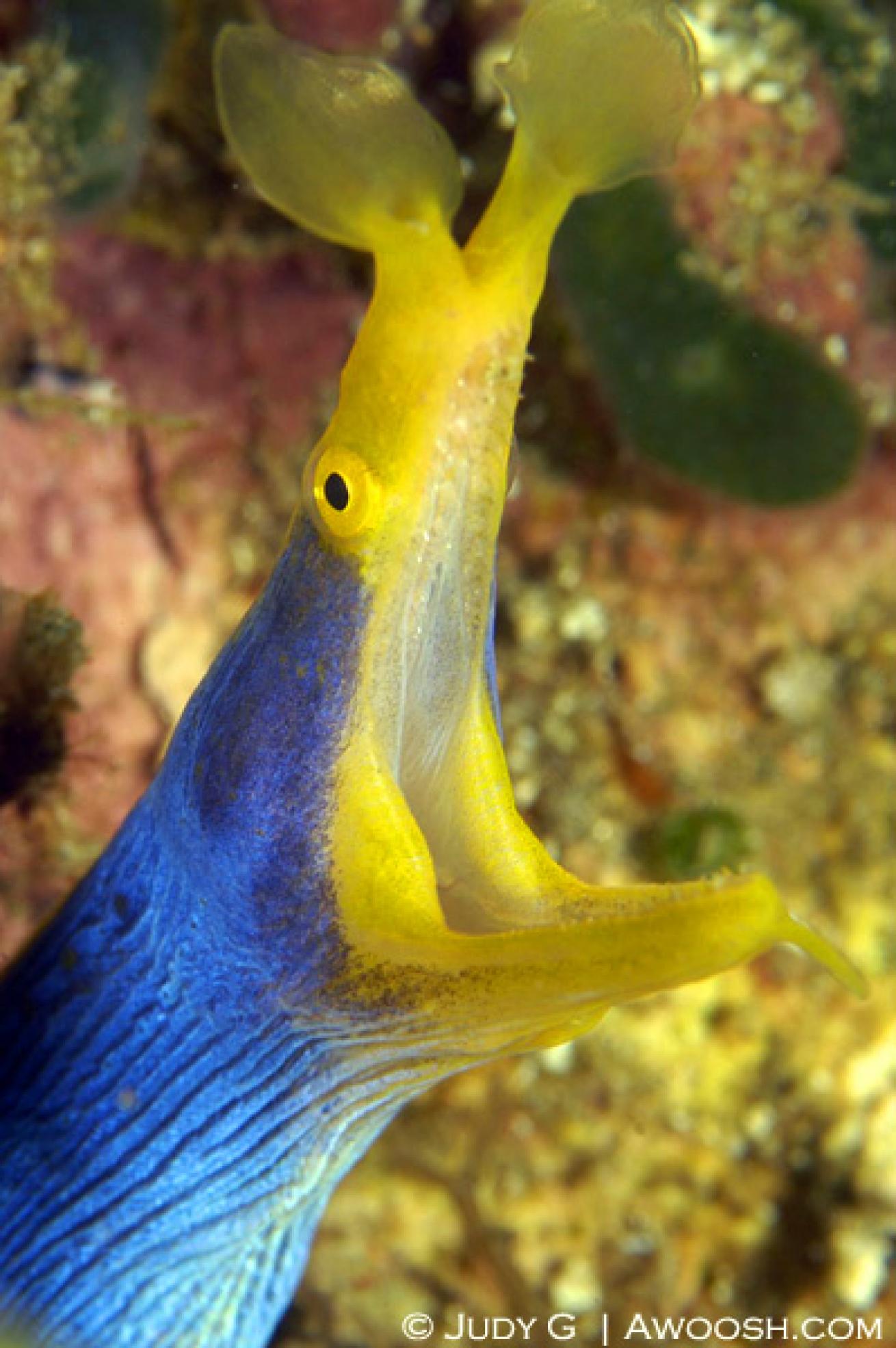
Judy G
(Fiji)
These beautiful eels are difficult photography subjects, as they tend to recede into their dens on a diver’s approach, and it can be a long wait before they come out again. Juveniles are black with a fine yellow dorsal fin, and females are all yellow. This is a mature male.
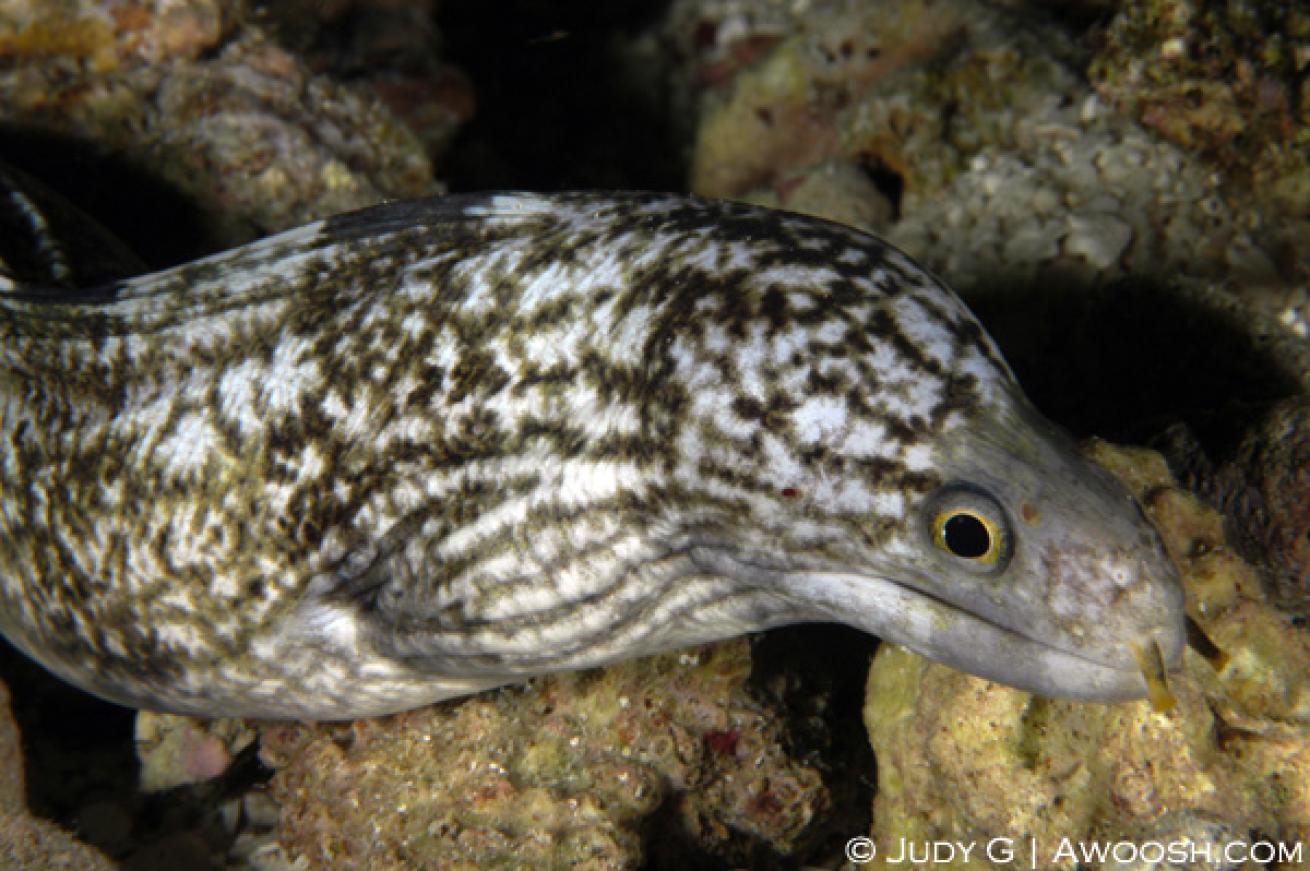
Judy G
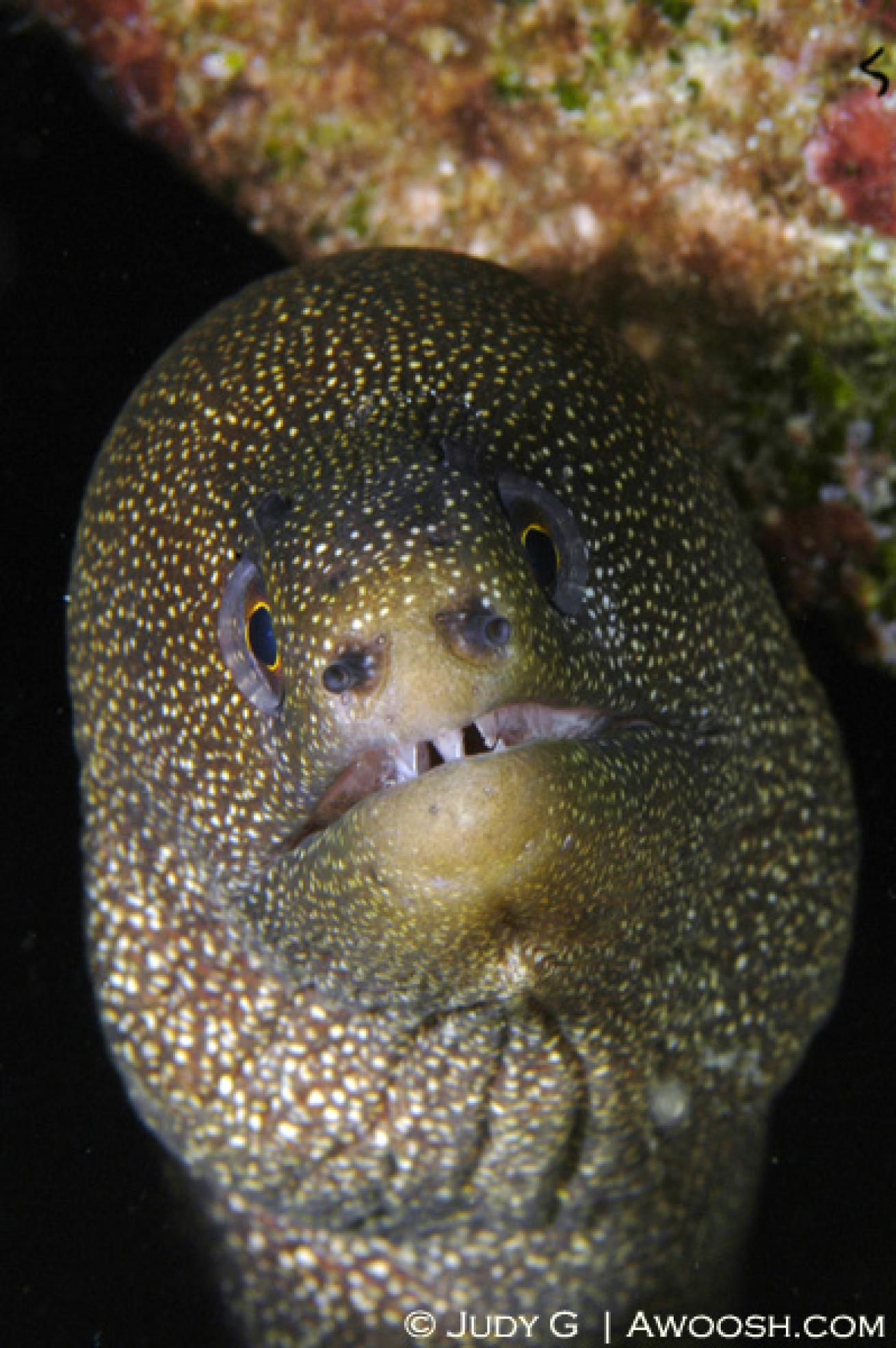
Judy G
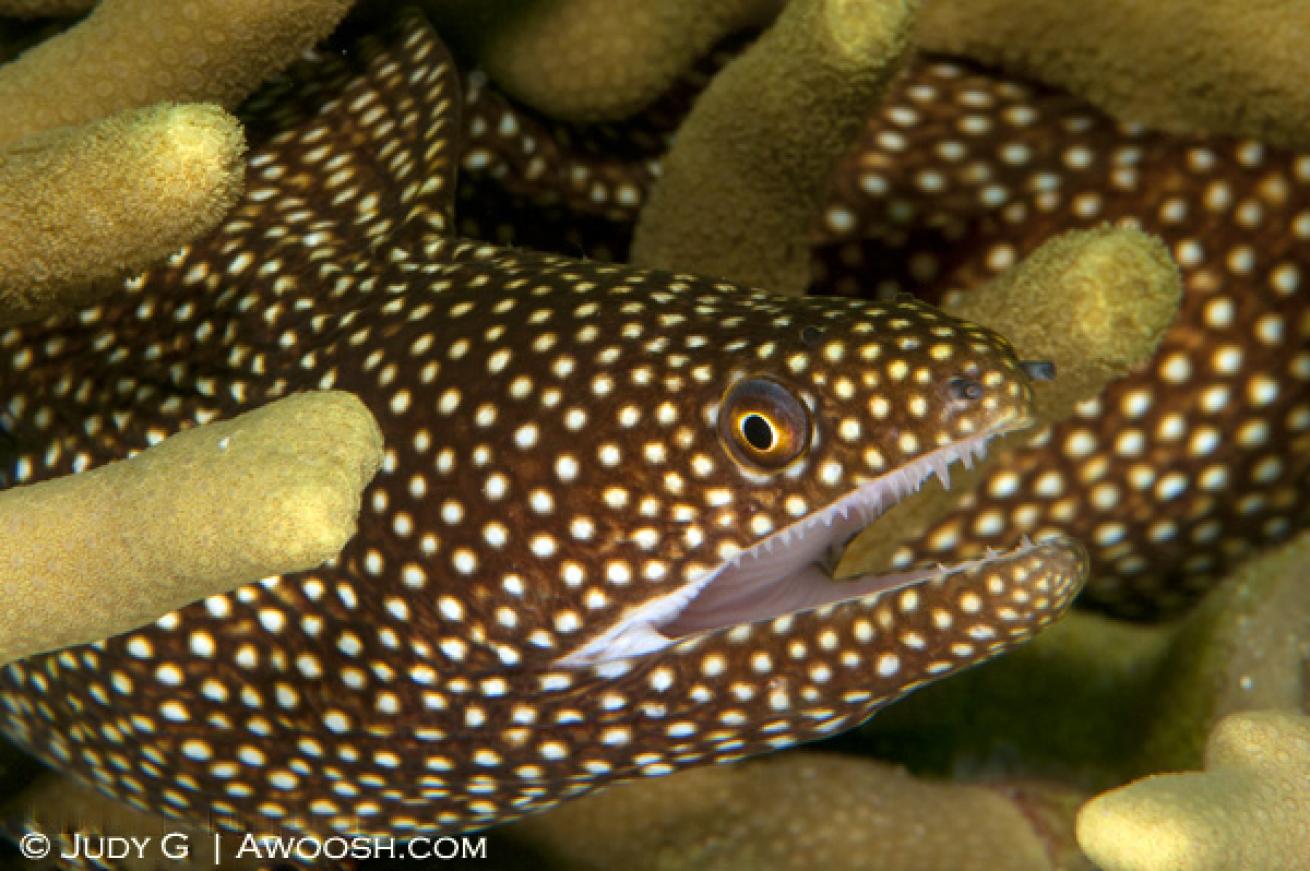
Judy G(Southeastern Sulawesi Island, Indonesia)
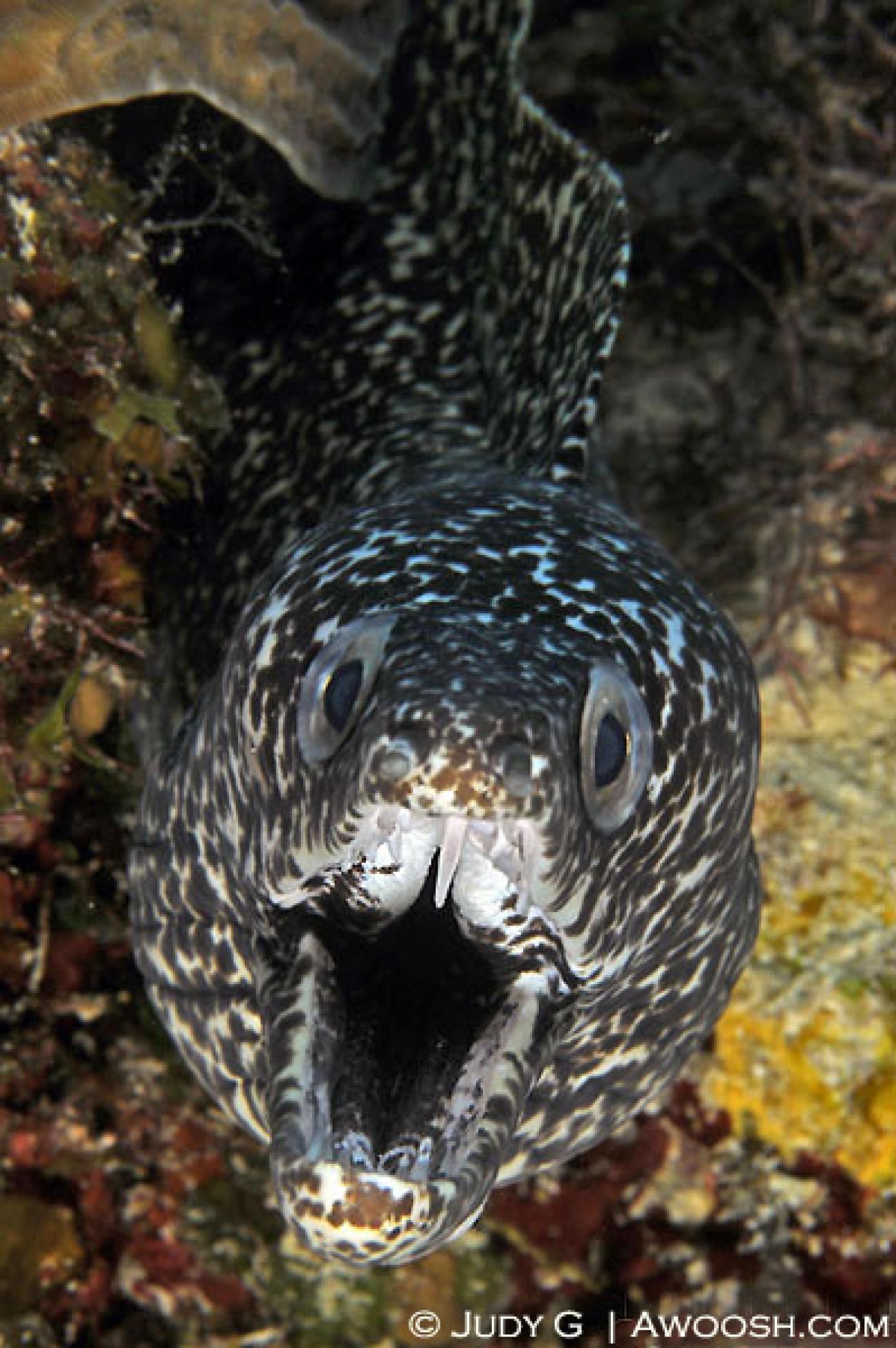
Judy G(Cozumel)
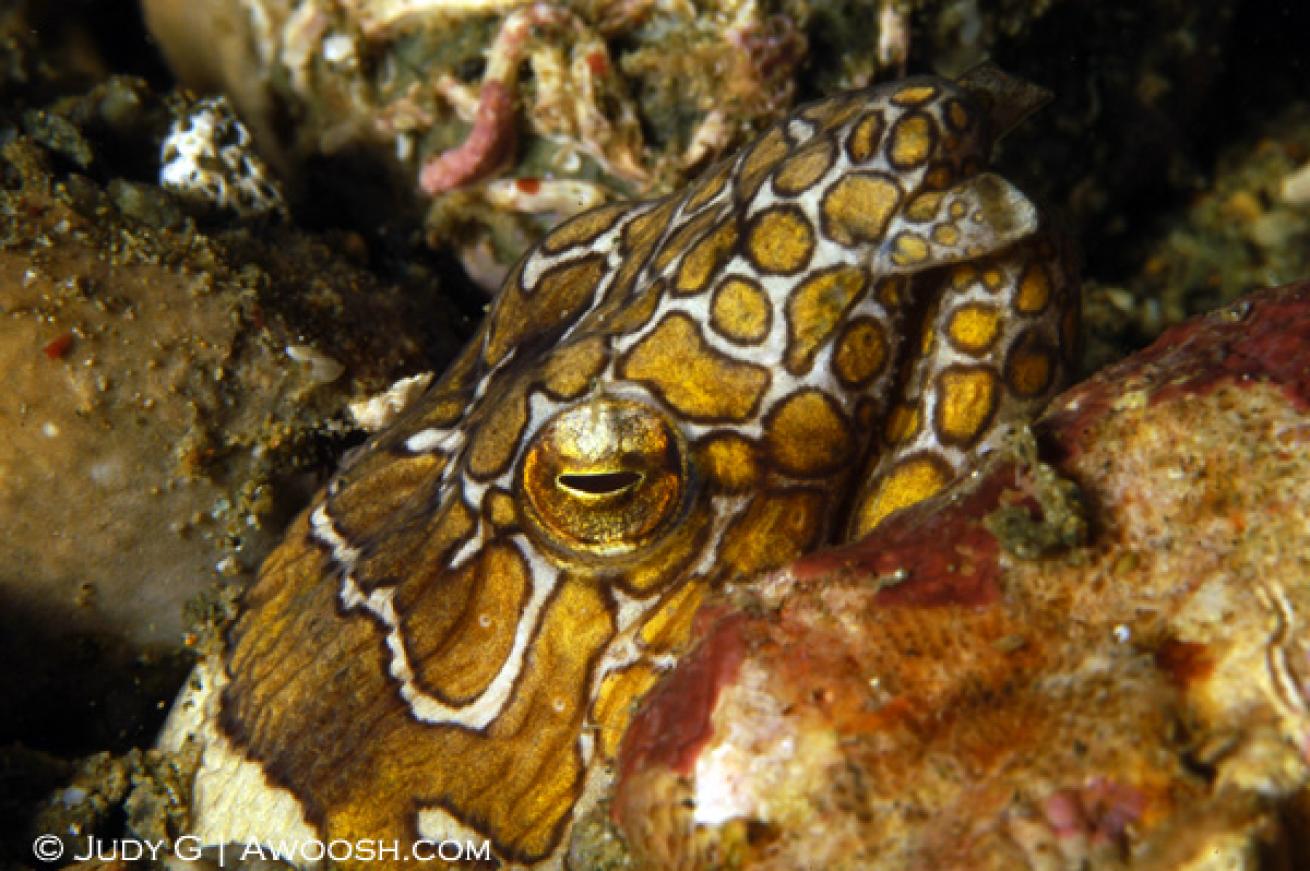
Judy G(Ambon Island, Indonesia)
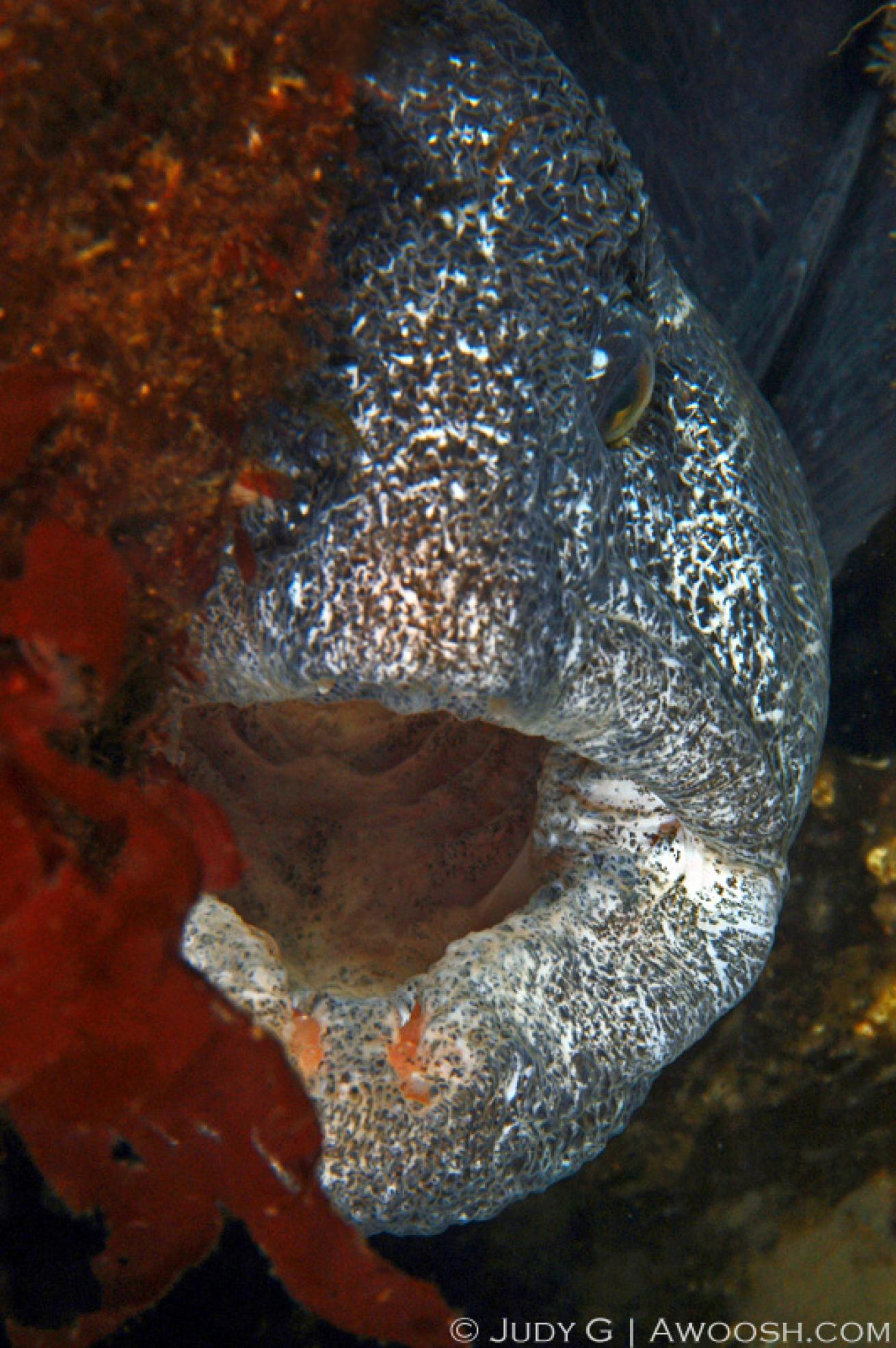
Judy G
(Nanaimo, British Columbia)
This fish is so ugly that it is cute. Wolf Eels are a favorite critter for cold water divers. They live in dens on the reef, often in mated pairs, and like many other eels are quite shy and tend to retreat into their lairs on approach.
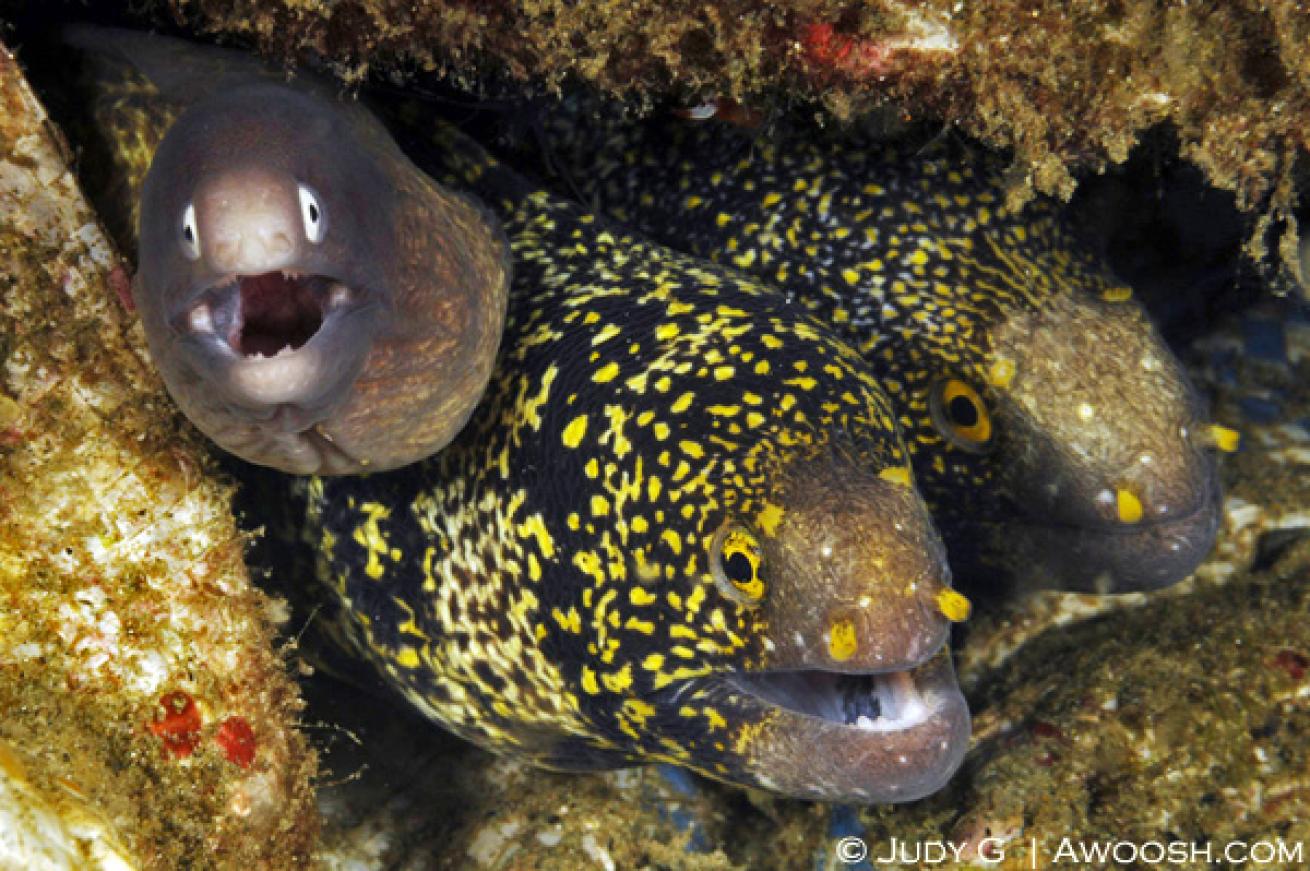
Judy G
(Ambon Island, Indonesia)
Ambon Harbor in Indonesia and the northern Galapagos Islands (Wolf & Darwin) are by far the eeliest destinations I’ve visited. With such a high population of eels, sometimes they apparently need to shack up together. In this group, there are two Snowflake Eels and a White Eyed Eel sharing the condo.
Eely Spooky Fish
With long, undulating bodies, most eels look a lot like snakes, but they are in fact fish. Eels can be very scary looking creatures as many varieties “gasp” constantly (which looks like a cross between biting and gulping behavior), and in doing so, bare their often-sharp fangs. But what they are really doing is forcing water over their gills to breathe. Eels also often have big bulbous eyes, and strange tubular nostrils, which add to the overall spooky effect.
But eels are generally quite safe for divers to approach, although keeping a respectful distance is a good idea, as it is thought that eels do not see very well, and could mistake your fingers or hands for their regular diet of fish and crustaceans. They tend to retreat from divers into their dens on the reef when approached, and most often are only seen out free swimming while they hunt at night.
There have been a few documented incidents of eels biting and injuring divers. From what I understand, this was because the divers in question were attempting to hand feed eels, and the eels in turn bit the hand that was feeding them, most likely out of mistaken identity. People may also be bitten when gathering lobsters, as the lobster may be sharing real estate with an eel under a ledge or in hole on the reef, and eels do not like their lairs being disturbed or intruded upon. Eel bites can be very nasty injuries, as these animals can have razor sharp teeth and several species actually have a second jaw and set of teeth further down their throat, which act as barbs and can make it hard to get your hand back.
I have rarely seen eels behave aggressively towards each other, although I once witnessed a wild eel rodeo in the Galapagos (which is a very eely destination — the things fairly litter some of the sites). I am not sure what the trigger was, but there were a half dozen moray eels madly charging each other in some sort of excited melee. Yikes!
The only other good eel story I can share occurred when Mr. G and I were diving near Cabo San Lucas, when we were fairly new divers, which was many years ago now. We showed up at the harbor at the appointed hour and met our Mexican dive master. We watched, somewhat astonished, as he loaded his BC pockets with small dead bait fish. I remember turning to Mr. G and saying wryly, “no good can come of that.”
So off we went, dropping down on a dive not far from the beautiful arch. As we swam over a jumble of rocks, we saw one, then two, then several eels pop up out of their lairs, as if to say, “hm, I smell supper.” To compensate for their poor eyesight they apparently have a very keen sense of smell. One very large green eel then swam up out of the rocks and starting frisking the dive master. At first he was totally oblivious. We watched, from a safe distance, with both horror and humor, as the big eel wound himself around and through up between the diver’s legs to sniff at his BC pockets. Then, finally, the dive master looked down, realized what was happening, and freaked out! He pushed the eel away in a blaze of bubbles. Then he checked himself out all over to make sure the beast hadn’t bitten him, spinning wildly in the water as he did so, and then he opened his pockets and started flinging the fish bits away. His eyes were huge — borderline panic, and for the rest of the dive he kept checking his six, clearly worried that he was going to be the recipient of even more unwanted eel attention. I am betting that chumming the eels is no longer part of his dive guide routine ;^)
This gallery features 17 different types of eels of the many that I have photographed during my travels. The Caribbean is documented to have 7 different varieties of eels. The Tropical Pacific has over 70!
More Dive Adventures with Judy G
School Daze with Thousands of Fish | DANGER: Risky Reef Dwellers | Meeting Mr. Big

